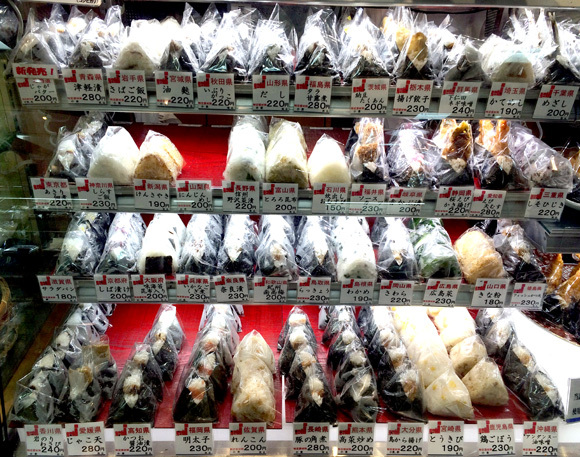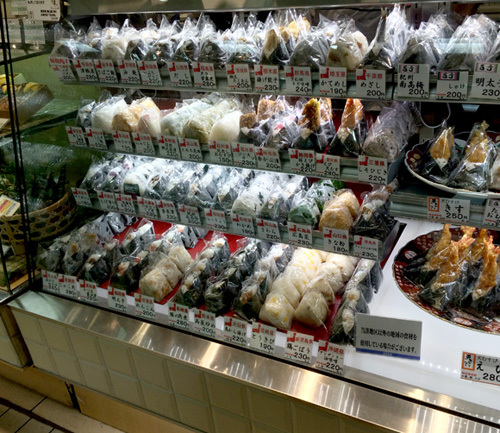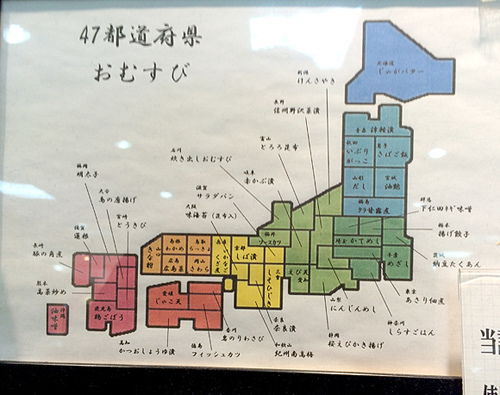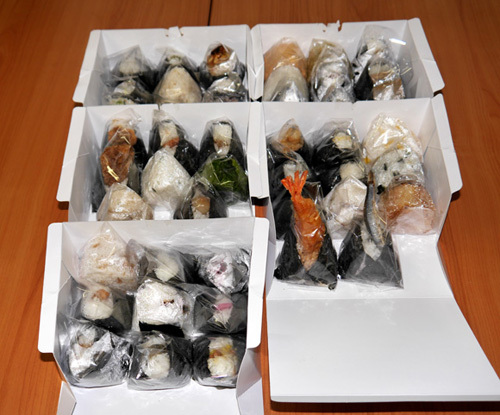
Although Japan lacks ethnic diversity, it seems to more than make up for it in diversity of cuisine. Although the overarching recipes of Japanese foods can be found everywhere, you’d be surprised and how diverse the differences can be from region to region. Having your New Year’s soup in Okayama Prefecture may be quite different from Akita Prefecture’s offering. Even purchasing oden from a chain like 7-Eleven will produce different results if it’s from Osaka or Tokyo.
This is also true of another of Japan’s standard foods: rice balls also known as onigiri or musubi. To taste all the unique variations Japan has to offer, one must be a seasoned traveler, or they could just go to Momochi, a shop which offers a taste of all 47 prefectures straight from the counter. Our own Mr. Sato, eager to taste of these deliciously distinct snacks, visited Momochi to sample one of each.
The following are Momochi’s 47 Prefecture rice balls with a very brief description. Note that the word “pickle” is often used but the various methods of pickling and vegetables used in different parts of Japan is extremely vast so consider each one unique. We also have photos of Mr. Sato posing with each rice ball presented in slide shows for each of Japan’s major regions. If you’d like to get a better idea of what they’re like or if you can get enough of Mr. Sato’s face, please check them out.
▼ Hokkaido & Tohoku area prefectures
NOT PICTURED
Fukushima – Tara Kanroni
Cod stewed in soy sauce and sugar
▼ Kanto area prefectures
NOT PICTURED
Gunma – Shimonita Negi Miso
Green onions and miso (fermented soy paste)
▼ Chubu area prefectures
NOT PICTURED
Yamanashi – Ninjin Meshi
Carrots
▼ Kansai area prefectures
▼ Chugoku area prefectures
NOT PICTURED
Okayama – Sawara
Japanese Spanish mackerel
▼ Shikoku area prefectures
▼ Kyushu & Okinawa
■ Couldn’t catch’em all!
Although Mr. Sato set out for nationwide domination of rice balls, his visit to the Momochi had a few setbacks. The store was completely out of Yamanashi’s Ninjin Meshi flavor, and the racks for Gunma’s Shimonita Negi Miso and Fukushima’s Tara Kanroni were both empty at the time of his visit. He could just barely get Fukui’s Sauce Katsu and Okayama’s Sawara. This left his final tally at 44 of the 47 prefectural rice balls. Not a bad haul, but sadly not all of them.
■ Best in show: Salad Pan Omusubi
After happily tasting all of the rice balls, Mr. Sato struggled to determine the best three. In the end he declared Shiga Prefecture’s Salad Pan flavor to be the best. It’s based on a brand of snack bread with mayonnaise and thinly chopped pickled daikon. Although the bread was substituted with rice it still had an excellent blending of tastes and was a neat concept overall. In second place was Aomori’s Tsugarudzuke followed by the Sawara rice ball from Okayama Prefecture. Really though, everyone’s a winner. Well, everyone except…
■ You doing okay over in Ishikawa?
For those who actually read through the entire list, you might have noticed the rice ball of Ishikawa being a little odd. Named Dakidashi Omusubi (or “Soup Kitchen Rice Ball” in English), it is an equally depressing recipe of simply rice and salt. Despite being a bit of a downer, Mr. Sato still thought it was tasty. So, if you want to broaden your culinary horizons in a fast and easy way, Momochi is well worth checking out.
Shop Information
Momochi
Odakyu Hyakkaten Shinjuku B2F, 1-1-3 Nishi, Shijuku, Tokyo
Weekdays: 10:00am to 8:30pm
Sundays/Holidays: 10:00am to 8:00pm
Original report by Mr. Sato
Photos: RocketNews24
The full list
Hokkaido – Potato Butter
Aomori – Tsugarudzuke
Local brand of herring roe pickled in soy sauce
Iwate – Sabagohan
Mackerel and vegetables
Miyagi – Aburafu
Fried wheat gluten
Akita – Iburigakko
Smoked vegetables such as daikon or carrots
Yamagata – Dashi
Minced and seasoned vegetables (not to be confused with the widely used Japanese soup “dashi”)
Fukushima – Tara Kanroni
Cod stewed in soy sauce and sugar
Ibaraki – Natto Takuan
Fermented soy beans and pickles
Tochigi – Age Gyoza
Fried gyoza
Gunma – Shimonita Negi Miso
Green onions and miso (fermented soy paste)
Saitama – Katemeshi
Grains, vegetables, and seaweed
Chiba – Mezashi
Small fish dried and baked
Tokyo – Asari Tsukudani
Clams boiled in soy sauce
Kanagawa – Shirasu Gohan
Really small and young fish (aka whitebait)
Niigata – Kenkiyaki
Miso grilled with yuzu peels and green onion
Yamanashi – Ninjin Meshi
Carrots
Nagano – Shinshu Nozawa Nadzuke
Pickles from Nozawa, Nagano
Toyama – Tororo Konbu
Grated yam and kelp
Ishikawa – Dakidashi Omusubi
“Soup Kitchen Musubi” (rice and salt only)
Fukui – Sauce Katsu
Breaded meat cutlet and sauce
Gifu – Akakabudzuke
Pickled red turnip
Shizuoka – Sakuraebi Kakiage
Fried sakura shrimp
Aichi – Ebiten Musu
Shrimp tempura
Mie – Shiso Hijiki
Shiga – Salad Pan
Mayo and finely chopped pickled daikon
Kyoto – Shibadzuke
Pickled eggplant and shiso
Osaka – Aji Nori Konbu Iri
“Filled with seaweed and kelp taste!”
Hyogo – Ikanago no Kugini
Small fish boiled in soy sauce and sugar until they look like nails
Nara – Naradzuke
Nara style pickles
Wakayama – Kishu Nanko Ume
A regional type of plum
Tottori – Rakkyo
A type of green onion
Shimane – Wakame
Seaweed
Okayama – Sawara
Japanese Spanish mackerel
Hiroshima – Hiroshimana
A leafy green vegetable
Yamaguchi – Kinako
Roasted and powdered soy beans
Tokushima – Fish Katsu Ten
Fish fillet tempura
Kagawa – Iwanori Wasabi
Seaweed and wasabi
Ehime – Jakoten
Fried fish paste
Kochi – Kastuo Shoyudzuke
Dried bonito picked in soy sauce
Fukuoka – Mentaiko
Seasoned cod roe
Saga – Renkon
Lotus root
Nagasaki – Kakuni
Simmered pork
Kumamoto – Takana Itame
Fried mustard leaves
Oita – Tori Karaage
Fried chicken
Miyazaki – Toukibi
Corn
Kagoshima – Niwatori Gobo
Chicken and burdock root
Okinawa – Andansu
Miso fried in pork fat




 What’s really for breakfast? 20 Japanese people give us a peek at their morning meal【Photos】
What’s really for breakfast? 20 Japanese people give us a peek at their morning meal【Photos】 We ate a pickled tapioca bubble rice bowl and it was un-bowl-lievable
We ate a pickled tapioca bubble rice bowl and it was un-bowl-lievable Katsudon vs. tonkatsu vs. katsu sandwich – What’s the best way to eat pork cutlet in Japan?
Katsudon vs. tonkatsu vs. katsu sandwich – What’s the best way to eat pork cutlet in Japan? Japan super budget dining – What’s the best way to spend 1,000 yen at sushi restaurant Sushiro?
Japan super budget dining – What’s the best way to spend 1,000 yen at sushi restaurant Sushiro? Japan Railways recently revealed ramen-style rice balls in its convenience stores
Japan Railways recently revealed ramen-style rice balls in its convenience stores Foreigner’s request for help in Tokyo makes us sad for the state of society
Foreigner’s request for help in Tokyo makes us sad for the state of society Seaside scenery, history, and so many desserts on Yokohama’s Akai Kutsu【Japan Loop Buses】
Seaside scenery, history, and so many desserts on Yokohama’s Akai Kutsu【Japan Loop Buses】 Should you add tartar sauce to Japanese curry rice? CoCo Ichi makes diners an unusual offer
Should you add tartar sauce to Japanese curry rice? CoCo Ichi makes diners an unusual offer Japanese city loses residents’ personal data, which was on paper being transported on a windy day
Japanese city loses residents’ personal data, which was on paper being transported on a windy day Akihabara pop-up shop sells goods made by Japanese prison inmates
Akihabara pop-up shop sells goods made by Japanese prison inmates Red light district sushi restaurant in Tokyo shows us just how wrong we were about it
Red light district sushi restaurant in Tokyo shows us just how wrong we were about it Japan’s cooling body wipe sheets want to help you beat the heat, but which work and which don’t?
Japan’s cooling body wipe sheets want to help you beat the heat, but which work and which don’t? Harajuku Station’s beautiful old wooden building is set to return, with a new complex around it
Harajuku Station’s beautiful old wooden building is set to return, with a new complex around it Smash Bros. director Sakurai stabs Kirby in the face, has delicious justification for it
Smash Bros. director Sakurai stabs Kirby in the face, has delicious justification for it Amazing exhibition of Japan’s legendary “cursed katana” is going on right now【Photos】
Amazing exhibition of Japan’s legendary “cursed katana” is going on right now【Photos】 McDonald’s new Happy Meals offer up cute and practical Sanrio lifestyle goods
McDonald’s new Happy Meals offer up cute and practical Sanrio lifestyle goods Japanese ramen restaurants under pressure from new yen banknotes
Japanese ramen restaurants under pressure from new yen banknotes French Fries Bread in Tokyo’s Shibuya becomes a hit on social media
French Fries Bread in Tokyo’s Shibuya becomes a hit on social media Studio Ghibli releases new action figures featuring Nausicaä of the Valley of the Wind characters
Studio Ghibli releases new action figures featuring Nausicaä of the Valley of the Wind characters New private rooms on Tokaido Shinkansen change the way we travel from Tokyo to Kyoto
New private rooms on Tokaido Shinkansen change the way we travel from Tokyo to Kyoto Tokyo Tsukiji fish market site to be redeveloped with 50,000-seat stadium, hotel, shopping center
Tokyo Tsukiji fish market site to be redeveloped with 50,000-seat stadium, hotel, shopping center Beautiful Ghibli sealing wax kits let you create accessories and elegant letter decorations【Pics】
Beautiful Ghibli sealing wax kits let you create accessories and elegant letter decorations【Pics】 Studio Ghibli releases Kiki’s Delivery Service chocolate cake pouches in Japan
Studio Ghibli releases Kiki’s Delivery Service chocolate cake pouches in Japan New definition of “Japanese whiskey” goes into effect to prevent fakes from fooling overseas buyers
New definition of “Japanese whiskey” goes into effect to prevent fakes from fooling overseas buyers Our Japanese reporter visits Costco in the U.S., finds super American and very Japanese things
Our Japanese reporter visits Costco in the U.S., finds super American and very Japanese things All-you-can-drink Starbucks and amazing views part of Tokyo’s new 170 meter-high sky lounge
All-you-can-drink Starbucks and amazing views part of Tokyo’s new 170 meter-high sky lounge More foreign tourists than ever before in history visited Japan last month
More foreign tourists than ever before in history visited Japan last month New Pokémon cakes let you eat your way through Pikachu and all the Eevee evolutions
New Pokémon cakes let you eat your way through Pikachu and all the Eevee evolutions Disney princesses get official manga makeovers for Manga Princess Cafe opening in Tokyo
Disney princesses get official manga makeovers for Manga Princess Cafe opening in Tokyo Sales of Japan’s most convenient train ticket/shopping payment cards suspended indefinitely
Sales of Japan’s most convenient train ticket/shopping payment cards suspended indefinitely Sold-out Studio Ghibli desktop humidifiers are back so Totoro can help you through the dry season
Sold-out Studio Ghibli desktop humidifiers are back so Totoro can help you through the dry season Japanese government to make first change to romanization spelling rules since the 1950s
Japanese government to make first change to romanization spelling rules since the 1950s Ghibli founders Toshio Suzuki and Hayao Miyazaki contribute to Japanese whisky Totoro label design
Ghibli founders Toshio Suzuki and Hayao Miyazaki contribute to Japanese whisky Totoro label design Doraemon found buried at sea as scene from 1993 anime becomes real life【Photos】
Doraemon found buried at sea as scene from 1993 anime becomes real life【Photos】 Tokyo’s most famous Starbucks is closed
Tokyo’s most famous Starbucks is closed One Piece characters’ nationalities revealed, but fans have mixed opinions
One Piece characters’ nationalities revealed, but fans have mixed opinions We asked a Uniqlo employee what four things we should buy and their suggestions didn’t disappoint
We asked a Uniqlo employee what four things we should buy and their suggestions didn’t disappoint Princesses, fruits, and blacksmiths: Study reveals the 30 most unusual family names in Japan
Princesses, fruits, and blacksmiths: Study reveals the 30 most unusual family names in Japan We Put A Bowl of Tonkotsu Ramen into a Rice Ball: Japan’s new demonic combini temptation
We Put A Bowl of Tonkotsu Ramen into a Rice Ball: Japan’s new demonic combini temptation Hungry for love – 10 dishes Japanese men want their girlfriends to cook for them
Hungry for love – 10 dishes Japanese men want their girlfriends to cook for them Former sushi chef serves onigiri rice balls for breakfast at new morning restaurant in Japan
Former sushi chef serves onigiri rice balls for breakfast at new morning restaurant in Japan We take a close-up look at some Japanese street food found at summer festivals【Photos】
We take a close-up look at some Japanese street food found at summer festivals【Photos】 Frozen pudding pops among the many surprises at Ramen Deniro in Tokyo
Frozen pudding pops among the many surprises at Ramen Deniro in Tokyo It turns out deep frying grilled rice balls makes them amazingly delicious【SoraKitchen】
It turns out deep frying grilled rice balls makes them amazingly delicious【SoraKitchen】 Japan super budget dining – What’s the best way to spend 1,000 yen at Family Mart?
Japan super budget dining – What’s the best way to spend 1,000 yen at Family Mart? This “Texas Pile” set lured us into a fried chicken shop for the first time, and we have no regrets
This “Texas Pile” set lured us into a fried chicken shop for the first time, and we have no regrets Tokyo Noriben Dog either reinvents or tarnishes the Japanese standard by putting a bento on a bun
Tokyo Noriben Dog either reinvents or tarnishes the Japanese standard by putting a bento on a bun Professional Chinese food chef teaches us how to make the perfect fried rice
Professional Chinese food chef teaches us how to make the perfect fried rice Disney’s Japanese breakfast in Hawaii probably tastes great, still looks weird
Disney’s Japanese breakfast in Hawaii probably tastes great, still looks weird Ironically, this video of a typical Japanese breakfast doesn’t show one
Ironically, this video of a typical Japanese breakfast doesn’t show one What does vegan ramen taste like? We try Veggie Brown Rice Ramen
What does vegan ramen taste like? We try Veggie Brown Rice Ramen Onigiri Bread from Japanese convenience store chain changes everything we know about rice balls
Onigiri Bread from Japanese convenience store chain changes everything we know about rice balls
Leave a Reply